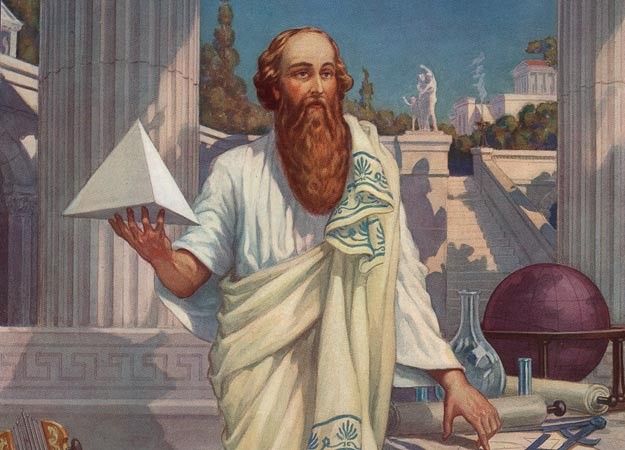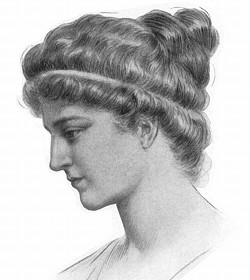(Mileto,
actual Turquía, 624 a.C., 548 a.C.) Filósofo y matemático griego. En su
juventud viajó a Egipto, donde aprendió geometría de los sacerdotes de Menfis,
y astronomía, que posteriormente enseñaría con el nombre de astrosofía. Dirigió
en Mileto una escuela de náutica, construyó un canal para desviar las aguas del
Halis y dio acertados consejos políticos. Fue maestro de Pitágoras y
Anaxímenes, y contemporáneo de Anaximandro.
En
geometría, y en base a los conocimientos adquiridos en Egipto, elaboró un
conjunto de teoremas generales y de razonamientos deductivos a partir de estos.
Todo ello fue recopilado posteriormente por Euclides en su obra Elementos, pero
se debe a Tales el mérito de haber introducido en Grecia el interés por los
estudios geométricos.
(Miletus, present-day Turkey, 624 BC, 548 BC) Greek philosopher and mathematician. In his youth he traveled to Egypt, where he learned geometry from the priests of Memphis, and astronomy, which he would later teach under the name of astrosophy. He directed a nautical school in Miletus, built a canal to divert the waters of the Halis, and gave sound political advice. He was the teacher of Pythagoras and Anaximenes, and a contemporary of Anaximander.
In geometry, and based on the knowledge acquired in Egypt, he elaborated a set of general theorems and deductive reasoning from these. All this was later compiled by Euclid in the work Elements of him, but Thales is due to the merit of having introduced in Greece the interest in geometric studies.
(Cirene, c. 284 a.J.C. -
Alejandría, c. 192 a.J.C.) Astrónomo, geógrafo, matemático y filósofo griego,
una de las figuras más eminentes del gran siglo de la ciencia griega: el
de Euclides, Arquímedes y Apolonio. Once años menor que Arquímedes,
mantuvo con éste relaciones de amistad y correspondencia científica. Cultivó no
sólo las ciencias, sino también la poesía, la filología y la filosofía, por lo
que fue llamado por sus coetáneos "pentatleta", o sea campeón de
muchas especialidades.
(Cyrene, c. 284 BC - Alexandria, c. 192 BC) Greek astronomer, geographer, mathematician and philosopher, one of the most eminent figures of the great century of Greek science: that of Euclid, Archimedes and Apollonius. Eleven years younger than Archimedes, he maintained friendships and scientific correspondence with him. He cultivated not only the sciences, but also poetry, philology and philosophy, which is why he was called by his contemporaries "pentathlete", that is, a champion of many specialties.
(Muhammad o Muhammed ibn Musa
al-Khwarizmi, al-Juarismi o al-Jwarizmi; ?-?, c.850) Matemático árabe.
Escribió una obra titulada Libro de la reducción, cuya versión latina tuvo
gran influencia en la matemática europea hasta mediados del siglo XV. En ella
indicó las primeras reglas del cálculo algebraico: la transposición de los
términos de uno a otro miembro de una ecuación, previo cambio de signo, y la
anulación de términos idénticos en ambos miembros. También estudió las
ecuaciones de segundo grado y otras cuestiones matemáticas. La latinización de
su nombre dio lugar a la palabra «guarismo».
(Muhammad or Muhammed ibn Musa al-Khwarizmi, al-Juarismi or al-Jwarizmi;? - ?, c.850) Arabic mathematician. He wrote a work entitled Book of Reduction, the Latin version of which had great influence on European mathematics until the middle of the 15th century. In it he indicated the first rules of algebraic calculus: the transposition of the terms from one member of an equation to another, after changing the sign, and the cancellation of identical terms in both members. He also studied second grade equations and other math questions. The latinization of his name gave rise to the word «figure».
(Siglo III) Matemático griego.
Sus escritos contribuyeron de forma notable al perfeccionamiento de la notación
algebraica y al desarrollo de los conocimientos del álgebra de su época.
Mediante artificios de cálculo supo dar soluciones particulares a numerosos
problemas, y estableció las bases para un posterior desarrollo de importantes
cuestiones matemáticas.
Por su originalidad y sus
aportaciones, Diofanto fue llamado por los historiadores el padre de los
algebristas modernos.
Due to his originality and his contributions, Diophantus was called by historians the father of modern algebraists.
Pitágoras de Samos
Da nombre al Teorema de Pitágoras, que permite relacionar
los tres lados de un triángulo rectángulo, comprobar si lo es o saber el valor
de uno de los lados (ángulo hipotenusa y los dos lados catetos). También
teorizó la Armonía de las esferas, basada en la idea de que el universo sigue
proporciones numéricas armoniosas y que el movimiento de los cuerpos se rige en
intervalos musicales.
Pitágoras de Samos
It gives its name to the Pythagorean Theorem, which allows us to relate the three sides of a right triangle, check if it is or know the value of one of the sides (hypotenuse angle and the two leg sides). He also theorized the Harmony of the spheres, based on the idea that the universe follows harmonious numerical proportions and that the movement of bodies is governed by musical intervals.
Escribió sobre geometría, álgebra y astronomía, y es
considerada la primera mujer científica de la historia. Esta matemática,
astrónoma y filósofa mejoró el diseño de los primitivos astrolabios, inventó el
densímetro y desarrolló una gran labor divulgativa en el Museo; institución
donde se educó y de la que posteriormente se convirtió en directora.
Hipatia de Alejandría
She wrote on geometry, algebra, and astronomy, and is considered the first woman scientist in history. This mathematician, astronomer and philosopher improved the design of the primitive astrolabe, invented the hydrometer and carried out a great informative work in the Museum; institution where she was educated and of which she later became director.
Leonhard Euler
Filósofo y matemático suizo, comenzó sus estudios
universitarios con 13 años. Es conocido por el número de Euler: un número
irracional que se toma como base de los logaritmos neperianos (2.718281828) y
que aparece en muchas fórmulas de cálculo y física. Trabajó en distintas áreas
de las matemáticas: introdujo la notación matemática y el concepto de función,
desarrolló la topología y la teoría de los números, destacando también en el
terreno del álgebra.
Leonhard Euler
Swiss philosopher and mathematician, he began his university studies at the age of 13. He is known by the Euler number: an irrational number that is taken as the base of natural logarithms (2.718281828) and that appears in many formulas of calculation and physics. He worked in different areas of mathematics: he introduced mathematical notation and the concept of function, developed topology and number theory, and also excelled in the field of algebra.
Leonardo Filius Bonacci fue un matemático innovador del
siglo XIII cuyo ‘Libro de cálculo’ popularizó la numeración arábiga; el sistema
numérico utilizado actualmente (1, 2, 3, 4…). Su gran descubrimiento
surgió cuando intentaba resolver un enigma sobre los hábitos de apareamiento de
los conejos: la secuencia de Fibonnaci, que comienza con los números 0 y 1 y a
partir de ellos, cada término se convierte en la suma de los dos anteriores, es
decir, en una relación de recurrencia.
Fibonacci
Leonardo Filius Bonacci was an innovative 13th century mathematician whose "Calculation Book" popularized Arabic numerals; the number system currently used (1, 2, 3, 4…). His great discovery arose when he was trying to solve an enigma about the mating habits of rabbits: the Fibonnaci sequence, which begins with the numbers 0 and 1 and from them, each term becomes the sum of the previous two, that is, , in a recurrence relationship.
Mary Cartwright
Se graduó en Matemáticas (1923) en la Universidad de Oxford y fue la primera mujer en
ocupar la presidencia de London Mathematical Society y en recibir la Medalla
Sylvester para la investigación matemática. Construyó el Teorema de Cartwright
basado en los máximos de funciones y trabajó con John Edensor Littlewood en
ecuaciones diferenciales que sirvieron de modelo para el desarrollo de la radio
y el radar.
Mary Cartwright
She graduated in Mathematics (1923) from Oxford University and was the first woman to hold the presidency of the London Mathematical Society and to receive the Sylvester Medal for mathematical research. She built Cartwright's Theorem based on function maxima and worked with John Edensor Littlewood on differential equations that served as models for the development of radio and radar.








No hay comentarios.:
Publicar un comentario